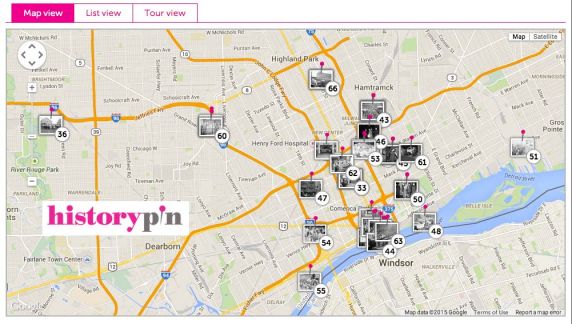HistoryPin: Tour the Detroit Sit-Down Strikes of 1937
The Reuther Library is pleased to announce its partnership with HistoryPin. For the uninitiated, HistoryPin is a popular, interactive social media platform that uses geotagging to link historical photographs to modern mapping systems. Partnering institutions and individuals--currently thousands across the globe-- “pin” still images, audio resources, or moving images to their subject’s original location. These pins can be grouped together in a tour or collection, each allowing for the individual user to explore historical topics or locations. The platform is widely available through a website or via mobile device applications.
The first of our many planned tours is “1937: Year of the Sit-Down Strike.” The tour guides the viewer through a visual sampling of some of the strikes in Detroit in 1937 and examines the effect of the strikes on the city.
During the Great Depression, wages, benefits, and working conditions were common causes of concern for Detroit’s workforce, yet most employees feared they had no recourse. Long lines of replacement workers waiting in the wings and eager for a job, lent employers no incentive to negotiate. The success of the great Flint Sit-Down Strike of 1936-1937, a 44-day stand-off between management and the National Guard on one side and several thousand General Motors employees on the other, emboldened many industrial workers. Dozens of sit-downs on smaller scales soon followed.
It was in February of 1937 that the public face of the strikes changed. 108 women, clerks and waitresses at the F.W. Woolworth and Co. dime store in downtown Detroit, rallied behind the call from a representative of the the American Federation of Labor’s Waiters and Waitresses Union and barricaded themselves in their store. The Woolworth “girls,” as they were affectionately known by in the press, were a nationwide sensation. Their eight-day strike served as the inspiration for thousands of workers throughout the city, particularly women, and proved that sit-downs were no longer the sole purview of male industrial workers. Before long, retail workers, hotel employees, waitresses, upholsterers and cigar workers were locking themselves in their places of employment, with or without the support of union representatives, for hours and even weeks at a time. The strikes, ranged from a handful of women holding down a small lunch counter to an enormous effort by the United Auto Workers Union (UAW) that shut down the region’s six Chrysler plants for seventeen days.
The logistics of the larger strikes were aided by massive community support that provided strikers with food and other necessities. Volunteers picketed to serve as human barriers between the police and the strikers. The strikes were not all successful. Some companies, such as Yale & Towne Co., chose to close their shop rather than deal with organized labor. Strikers were sometimes harmed during their forced removal from buildings by local police officers. Others were exposed to chemical agents such as tear gas. One of the more violent incidents happened at the Bernard Schwartz Cigar Factory, where demonstrators were set upon by mounted police, resulting in numerous injuries and hospitalizations.
As the year wore on the strikes slowed down, with the majority being resolved by late June. Thousands of workers were now represented by a union, though for others, the struggle for the right to organize would continue. Whether the sit-downs succeeded or failed was mostly irrelevant; the strikes had a lasting effect on the economic landscape of the city. By sitting down, the workers and their supporters proved to business owners that organized labor was a stronger force than previously thought and that Detroit was, firmly, a union town.
We hope you enjoy the tour!
- eclemens's blog
- Login to post comments
- Printer-friendly version


 Reddit
Reddit Facebook
Facebook LinkedIn
LinkedIn